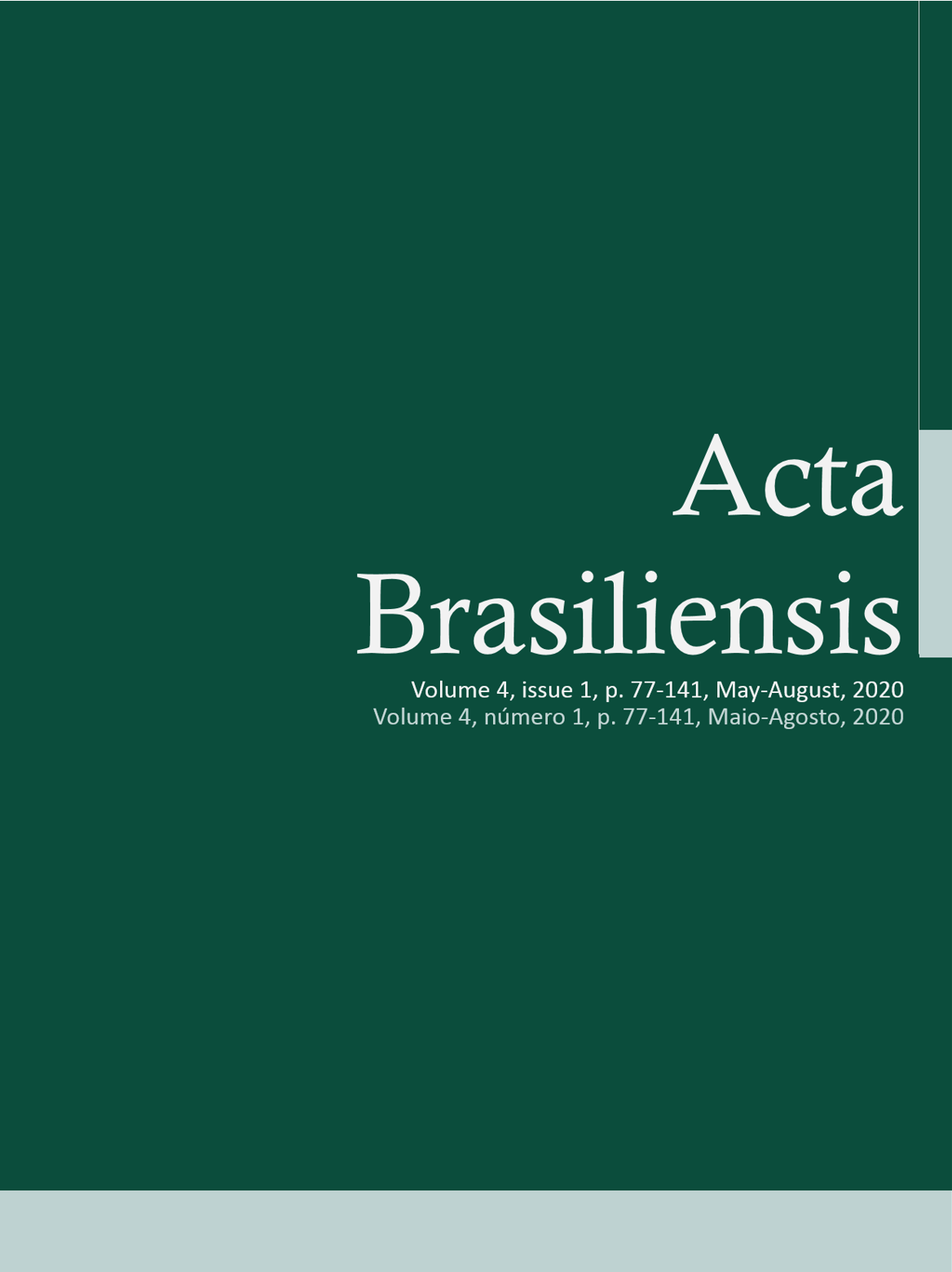Efficiency of Bacillus thuringiensis biofilters on 17β-estradiol removal
Abstract
This study evaluated the potential of Bacillus thuringiensis biofilters and natural substrates for removal of the natural estrogen 17β-estradiol (E2) in aqueous solutions. Filters biologically activated with this bacterium and containing rice husk ash (RHA) or activated carbon (AC) were monitored for 20 days for biofilm formation. In all samples, E2 was quantified by SPE (solid phase extraction) and LC-MS/MS (liquid chromatography coupled to mass spectrometry). The results showed 83% removal for the biofilter containing RHA and 86% for AC, indicating the potential of the bacterium Bacillus thuringiensis to biodegrade E2. This study demonstrated that biofiltration can be a method used for E2 removal.
Downloads
References
Aquino, S. F. de, Brandt, E. M. F., & Chernicharo, C. A. de L. (2013). Remoção de fármacos e desreguladores endócrinos em estações de tratamento de esgoto: revisão da literatura. Engenharia Sanitaria e Ambiental, 18(3), 187–204. doi: 10.1590/s1413-41522013000300002
Borges, R. M., Minillo, A., Lemos, E. G. de M., do Prado, H. F. A., & Tangerino, E. P. (2016). Uso de filtros de carvão ativado granular associado a microrganismos para remoção de fármacos no tratamento de água de abastecimento. Engenharia Sanitaria e Ambiental, 21(4), 709–720. doi: 10.1590/S1413-41522016118787
Bundy, M. M., Doucette, W. J., McNeill, L., & Ericson, J. F. (2007). Removal of pharmaceuticals and related compounds by a bench-scale drinking water treatment system. Journal of Water Supply: Research and Technology - AQUA, 56(2), 105–115. doi: 10.2166/aqua.2007.091
Campanha, M. B., Awan, A. T., de Sousa, D. N. R., Grosseli, G. M., Mozeto, A. A., & Fadini, P. S. (2015). A 3-year study on occurrence of emerging contaminants in an urban stream of São Paulo State of Southeast Brazil. Environmental Science and Pollution Research, 22(10), 7936–7947. https://doi.org/10.1007/s11356-014-3929-x
Campos, J. M., Queiroz, S. C. N., & Roston, D. M. (2019). Removal of the endocrine disruptors ethinyl estradiol, bisphenol a, and levonorgestrel by a laboratory scale subsurface constructed wetlands. Science of The Total Environment. doi: 10.1016/j.scitotenv.2019.07.320
Czajka, C. P., & Londry, K. L. (2006). Anaerobic biotransformation of estrogens. Science of the Total Environment, 367(2–3), 932–941. doi: 10.1016/j.scitotenv.2006.01.021
Ferreira, L., Rosales, E., Danko, A. S., Sanromán, M. A., & Pazos, M. M. (2016). Bacillus thuringiensis a promising bacterium for degrading emerging pollutants. Process Safety and Environmental Protection, 101, 19–26. doi: 10.1016/j.psep.2015.05.003
Fu, Y., Shen, Y., Zhang, Z., Ge, X., & Chen, M. (2019). Activated bio-chars derived from rice husk via one- and two-step KOH-catalyzed pyrolysis for phenol adsorption. Science of the Total Environment, 646, 1567–1577. doi: 10.1016/j.scitotenv.2018.07.423
Ghiselli, G., & Jardim, W. F. (2007). Interferentes endócrinos no ambiente. Quimica Nova, 30(3), 695–706. doi: 10.1590/S0100-40422007000300032
Kieling, A. G. (2016). Adsorção de BTEX - Benzeno, Tolueno, Etilbenzeno e Xileno - em cinza de casca de arroz e carvão ativado. Universidade Federal do Rio Grande do Sul.
Li, J., Han, X., Brandt, B. W., Zhou, Q., Ciric, L., & Campos, L. C. (2019). Physico-chemical and biological aspects of a serially connected lab-scale constructed wetland-stabilization tank-GAC slow sand filtration system during removal of selected PPCPs. Chemical Engineering Journal, 369(January), 1109–1118. doi: 10.1016/j.cej.2019.03.105
Machado, K. S. (2010). Determinação de hormônios sexuais femininos na bacia do Alto Iguaçu, região metropolitana de Curitiba-PR. Universidade Federal do Paraná.
Montagner, C., Sodré, F., Acayaba, R., Vidal, C., Campestrini, I., Locatelli, M., … Jardim, W. (2019). Ten Years-Snapshot of the Occurrence of Emerging Contaminants in Drinking, Surface and Ground Waters and Wastewaters from São Paulo State, Brazil. Journal of the Brazilian Chemical Society, 30(3), 614–632. doi: 10.21577/0103-5053.20180232
Nazari, E., & Suja, F. (2016). Effects of 17β-estradiol (E2) on aqueous organisms and its treatment problem: A review. Reviews on Environmental Health, 31(4), 465–491. doi: 10.1515/reveh-2016-0040
Ngah, W. S. W., & Hanafiah, M. A. K. M. (2008). Removal of heavy metal ions from wastewater by chemically modified plant wastes as adsorbents: A review. Bioresource Technology, 99(10), 3935–3948. doi: 10.1016/j.biortech.2007.06.011
Riva, F., Castiglioni, S., Fattore, E., Manenti, A., Davoli, E., & Zuccato, E. (2018). Monitoring emerging contaminants in the drinking water of Milan and assessment of the human risk. International Journal of Hygiene and Environmental Health, 221(3), 451–457. doi: 10.1016/j.ijheh.2018.01.008
Sbardella, L., Comas, J., Fenu, A., Rodriguez-Roda, I., & Weemaes, M. (2018). Advanced biological activated carbon filter for removing pharmaceutically active compounds from treated wastewater. Science of the Total Environment, 636, 519–529. doi: 10.1016/j.scitotenv.2018.04.214
Simpson, D. R. (2008). Biofilm processes in biologically active carbon water purification. Water Research, 42(12), 2839–2848. doi: 10.1016/j.watres.2008.02.025
Spohr, D. L., Cirio, E., Pizzolato, T. M., & Ruschel, C. K. (2014). Utilização de microrganismos na degradação de hormônios estrógenos. Revista Liberato, 15(24), 155–166. doi: 10.31514/rliberato.2014v15n24.p155
Vilela, C. L. S., Bassin, J. P., & Peixoto, R. S. (2018). Water contamination by endocrine disruptors: Impacts, microbiological aspects and trends for environmental protection. Environmental Pollution, 235, 546–559. doi: 10.1016/j.envpol.2017.12.098
Westphalen, A. P. C., Corção, G., & Benetti, A. D. (2016). Utilização de carvão ativado biológico para o tratamento de água para consumo humano. Engenharia Sanitaria e Ambiental, 21(3), 425–436. doi: 10.1590/S1413-41522016143108
Ying, G. G., Kookana, R. S., & Ru, Y. J. (2002). Occurrence and fate of hormone steroids in the environment. Environment International, 28(6), 545–551. doi: 10.1016/S0160-4120(02)00075-2






